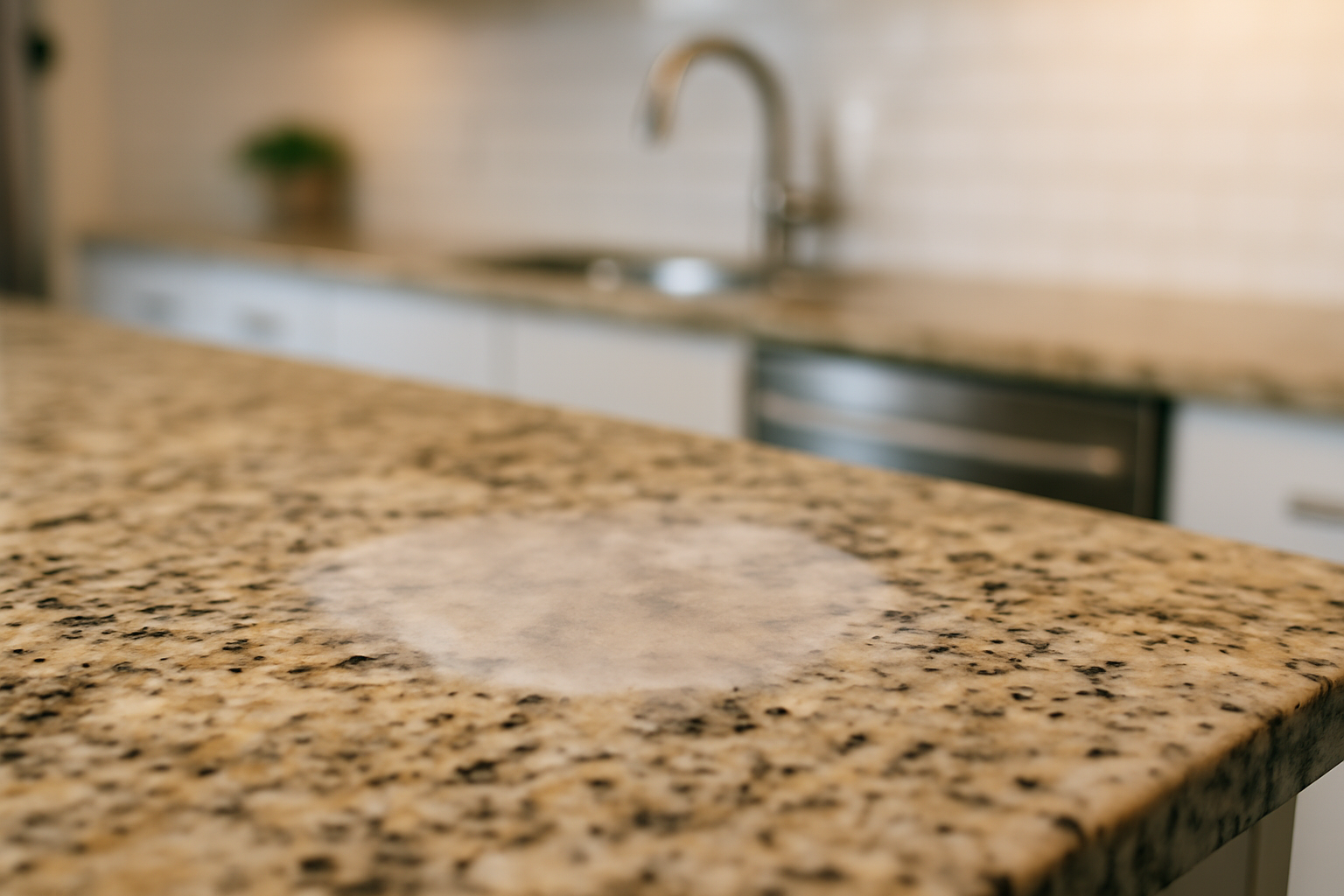Acetone on Granite Damage and How to Fix It

Acetone is a go-to solvent that frequently crosses paths with granite surfaces during cleaning, crafting or home improvement projects. This article looks at whether acetone can mess with granite, what kind of trouble it might cause and some down-to-earth tips for fixing or minimizing those effects.
Taking a Closer Peek at Granite and How It Deals with Chemicals
Granite is a natural stone that’s famous for being tough as nails and incredibly durable. It stands up well to heat and scratches. It’s mostly made of quartz, feldspar and mica. Its low porosity means it holds up well against many chemicals. That said, how long it lasts really depends on the quality of the stone and whether it’s been properly sealed.
What Acetone Is and Why People Actually Reach for It
Acetone is a clear fast-evaporating liquid that is a go-to solvent and cleaner in homes and industries alike. It effortlessly breaks down oils, paints, adhesives and some plastics. This explains why it is the usual suspect when removing nail polish, sprucing up surfaces or thinning certain chemicals. You’ll often spot acetone in kitchen and bathroom spots, especially near granite countertops. Because it’s a powerful solvent, a careless spill or prolonged contact with sensitive materials including some types of stone can cause damage.
Some Ways Acetone on Granite Might Just Play Havoc
Granite is naturally tough as nails but acetone can still sneak in and cause different types of surface and structural damage depending on how long it stays and the quality of the stone. This solvent might slip into sealants or react with minerals leading to discoloration, a dull finish or even etching on the surface. Acetone can also chip away at resin-based sealants and leave the stone more vulnerable than you would like.
- Color fading or those annoying patchy spots that show up when acetone strips away natural pigments or sealants
- Surface haze or dull patches that sneak in thanks to solvent residue messing around with the stone’s surface
- Breakdown or softening of the resin or acrylic sealants designed to shield the granite
- Granular erosion happening as alkali-sensitive minerals decide to weaken or flake off like they’re calling it quits
- Stains cropping up from substances dissolved by acetone that then sneak into the stone’s porous layers, making a bit of a mess
The extent of acetone damage on granite depends on a few key factors. First, how long the solvent stays on the surface plays a big role. Next, consider the type and finish of the granite as well as whether the stone has been sealed and what kind of sealant was used originally. You should also take into account the concentration or purity of the acetone because the stronger it is the more sensitive the stone can be.
A No-Nonsense Guide to Spotting Acetone Damage on Granite
Diagnosing acetone damage properly calls for a careful and methodical approach. It’s worth paying close attention to unusual colors and dull or rough patches. Subtle changes in the surface texture are also important. Running your fingers over the stone can often reveal shifts in smoothness or hardness that the eye might miss.
Take a good close look at the granite for any uneven color patches or faded spots. These areas often show where acetone has stripped away pigments or the sealant.
Watch for dull areas or a stubborn hazy film that won’t come off with your usual cleaning methods. This usually indicates leftover solvent or surface damage.
Gently test the surface hardness using your fingernail or a smooth tool. Look for any soft or grainy patches that don’t feel right.
Notice the texture and thickness of the sealant layer because acetone can cause it to peel, crack or thin out unexpectedly.
Try a small water drop test to see if water beads up nicely or soaks in too fast. This simple experiment can reveal if the sealant has been affected by acetone.

What You Can Do to Fix Acetone Damage on Granite (Because Yes, Accidents Happen)
Repairing acetone damage on granite usually involves a few careful steps. Start with gentle cleaning and gradually bring back the stone's protective layers. How you tackle it depends on the severity of the damage. Sometimes a bit of polishing does the trick. Other times you might need specialized poultices or even to refinish the surface entirely. When things get tricky, a professional restoration can work wonders by restoring the original shine and protection without making a mess.
Clean the area right away with a mild pH-neutral detergent and warm water—this will gently whisk away lingering acetone without causing further trouble.
Apply a granite-safe stone polish or a poultice designed to lift stains or restore dull spots and let it sit for the time recommended on the package.
Once you’ve cleaned and polished, reapply a high-quality granite sealant that’s tough enough to handle acetone exposure to give your surface extra protection.
For minor dull patches, a gentle buff with a fine polishing pad made just for granite should do the trick—avoid anything too harsh or you might cause more headaches.
If the damage is stubborn or goes beyond the surface, call a professional stone restoration expert who knows honing, polishing, or refinishing your stone without breaking a sweat.
Choosing safe cleaning products after acetone exposure is key to avoid making things worse. You don’t want to add insult to injury. It’s a good idea to stick with pH-neutral non-abrasive cleaners designed specifically for natural stone. Definitely steer clear of acidic or alkaline cleaners because they tend to react badly with damaged granite. When it’s time to reseal, opt for high-quality granite sealers that soak in deeply, last a long time and resist solvents effectively. Sealants with polymer additives usually provide tough durable protection while letting the stone’s natural beauty shine through.
How to Dodge Acetone Damage on Granite Without Breaking a Sweat
Preventing acetone damage is the best way to keep your granite looking sharp. Get into the habit of working carefully around granite and keep solvents away from stone surfaces. Throw on protective barriers during home or craft projects to reduce the risk. Regularly giving sealants some TLC builds a tough shield against accidental spills that seem to sneak up on you.
- Steer clear of acetone or anything with acetone near your granite surfaces because it damages stone.
- Opt for cleaners designed to work with granite and natural stones.
- Wipe up spills quickly with a soft cloth to prevent chemical damage.
- Keep your granite looking sharp by resealing it every year or when the pros suggest.
- Make sure everyone at home knows acetone is a no-go around your granite countertops to avoid accidents.
When It’s Time to Think About Professional Granite Restoration
Certain types of damage from acetone on granite are too severe for DIY fixes and require the pros. When you spot deep etching or widespread sealant failure or stubborn discolorations that no cleaning or polishing can remove, it’s the right moment to bring in a specialist. Professionals use advanced tools and techniques like honing, grinding and polishing compounds to restore granite safely and thoroughly.
- Clear surface pitting or corrosion that changes the stone’s texture in a noticeable way.
- A widespread dullness or chalky appearance that won’t perk up, no matter how much polishing or cleaning you throw at it.
- Trouble restoring the stone’s original shine, even after applying sealants or polish sometimes it feels like the sparkle is not coming back.
- Risk of causing even more damage if you try fixing things without the proper tools or know-how, which is a headache nobody needs.

Questions & Answers
Can a small, quick spill of acetone permanently damage my granite countertop?
A brief spill usually won’t cause lasting damage if you clean it up pronto, especially when your granite is properly sealed. The risk climbs the longer acetone lingers on the surface because it can start breaking down the sealant and let the solvent seep into the stone. This might leave dull spots or discoloration behind. It’s smarter to blot spills gently rather than wiping them around — you definitely don’t want to spread the acetone like butter on toast.
What should I do immediately after acetone spills on my granite?
Speed is your best friend here. Carefully blot the spill with a soft absorbent cloth to soak up as much acetone as possible without rubbing it in. Next, give the area a gentle clean with a mild pH-neutral stone cleaner mixed with warm water to clear away any sneaky residue. Resist the urge to experiment with other chemicals—they might react badly with the acetone and turn a small hiccup into a full-blown mess.
How can I tell if the damage is just on the sealant or if it has affected the granite itself?
A quick water test can be surprisingly telling. Drop a few drops of water on the affected spot. If it soaks right in and darkens the stone, your sealant’s probably taken a hit. If the surface feels rough or gritty or stubbornly dull and discolored, the damage might have sunk deeper into the granite. At that point, calling in a pro is usually the wise move.
Is it possible to fix acetone damage myself, or should I always call a professional?
For minor issues like slight dulling or a compromised sealant, you can often roll up your sleeves and polish with granite-specific products then reseal the surface. But if you’re staring down deep etching, serious discoloration, or a chalky texture that just won’t budge, it’s best to raise the white flag and call a professional before things spiral out of control.
After fixing the damage, how can I prevent this from happening again?
A stitch in time saves nine as they say. Keep acetone and similar solvents far away from your granite surfaces. Use protective mats or trays when handling these chemicals to avoid accidental drips. And above all, maintain a robust seal by applying a high-quality sealant once a year—trust me, a solid seal is your best armor against chemical sneak attacks.
What type of sealant is best for protecting granite from solvents like acetone?
Opt for a top-notch penetrating sealer that’s tailor-made for granite. Polymer-enhanced or impregnating sealers generally take the cake because they soak deep into the stone and create a strong invisible shield that outperforms surface coatings which solvents can easily wear away. It’s like giving your granite a suit of armor without the bulky metal clanking.





